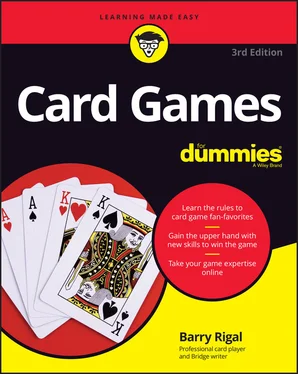If the person asked has no cards of the rank specified in the question, they reply “ Go Fish,” and the questioner takes a card from the stock. The questioner’s go ends, whether they pick up the card they were looking for or not. If the card that they draw from the stock completes a set, they must wait until their next turn to put the set down on the table. The turn passes to the player who sends their rival fishing.
 Some play that if the card you draw from the stock completes any set in your hand, or if you pick up the card you were unsuccessfully asking for, your turn continues.
Some play that if the card you draw from the stock completes any set in your hand, or if you pick up the card you were unsuccessfully asking for, your turn continues.
At the end of the game — which almost always occurs when all the cards are in everybody’s hands and the stock has been used up — you count the sets. The player who collects the most sets wins. However, if one player puts all their cards into sets before the stock gets used up, they win.
Authors resembles Go Fish in many ways, with a few interesting exceptions that make it a far more subtle game.
 At one time, people played Authors with special decks of cards bearing the pictures of famous authors. These decks are coming back into fashion; try
At one time, people played Authors with special decks of cards bearing the pictures of famous authors. These decks are coming back into fashion; try www.unclesgames.com .
The big difference between Authors and Go Fish is that the questions you ask other players must relate to specific cards rather than to a type of card. For example, you ask, “Do you have the ♠7?” instead of asking for 7s in general.
The other rules on asking questions are also quite specific:
You can’t ask for a card if you already have that card in your hand.
You can’t ask for a card unless you have at least one card of that set in your hand.
 If you have two cards of a set in your hand, hearing someone else ask for a third card in the set may pinpoint who has the cards you need. If player A successfully asks player B for the ♦Q, for example, they now have two queens, so you can collect them from that player at your next turn if you get the chance.
If you have two cards of a set in your hand, hearing someone else ask for a third card in the set may pinpoint who has the cards you need. If player A successfully asks player B for the ♦Q, for example, they now have two queens, so you can collect them from that player at your next turn if you get the chance.
An unsuccessful question means that the turn passes to the left rather than to the player who unsuccessfully asked for a card. Just as in Go Fish, when you complete a set, you place it on the table.
 If you ask for a card when you have nothing in that set, if you fail to provide a card when you’re asked for it, or if you fail to put down a set as soon as you can, you must give one set to the player to your left — a pretty severe charge!
If you ask for a card when you have nothing in that set, if you fail to provide a card when you’re asked for it, or if you fail to put down a set as soon as you can, you must give one set to the player to your left — a pretty severe charge!
When you run out of cards — because other players picked your hand clean or because you’ve made your hand into sets — you’re out, and the game continues without you until all the sets have been completed and no one has any cards left. Whoever has the most sets at the end wins.
Children love Cheat (which is also called I Doubt It) because it gives them the opportunity to develop their deceptive powers in a way that their parents approve of. Most children master the art of lying convincingly and looking guilty when telling the truth very early on.
 You need the following to play Cheat:
You need the following to play Cheat:
Three or more players: You can play with up to 12.
A standard deck of 52 cards: You normally play Cheat with a single deck of cards for up to five players. With 6 to 12 players, use two decks.
The object of Cheat is to get rid of all your cards as quickly as possible. To do that, you play your cards face-down, announcing what you put down — but you don’t have to tell the truth.
The dealer deals out all the cards one at a time, face-down and clockwise, and the players pick up and look at their cards. The player to the left of the dealer is first to play.
The first player puts down cards onto a central pile on the table, squaring the cards up so that other players can’t see precisely how many cards they have put down. They then make an announcement about their play, along the line of “three 6s” or whatever they consider appropriate. The statement can be false in more than one way. They may put down more or fewer cards than they claim, or they may put down cards unrelated to what they claim. The players who follow put their cards on top of theirs.
 Some people require that the play must consist of the correct number of cards, whether or not they are what you claim them to be.
Some people require that the play must consist of the correct number of cards, whether or not they are what you claim them to be.
If no player challenges the claim (and anyone can do so), the turn moves clockwise to the next player. The next player also makes a play face-down, and they have three choices:
To make a challenge, someone calls out “ Cheat,” and the player accused has two options:
They can concede (gracefully or otherwise) by picking up the entire pile.
They can turn over the cards they just put down to demonstrate that they were telling the truth, in which case the challenger must pick up the whole pile.
The player who picks up the pile from the center gets to start the next round with whatever number they want.
 If you have a dispute over who called out “ Cheat” first, the player nearest to the left of the accused has priority.
If you have a dispute over who called out “ Cheat” first, the player nearest to the left of the accused has priority.
If no one has called “ Cheat,” then the next player has to pick up from the last set put down. They have three choices as to what to play.
They can claim to be playing the same rank as the previous player: If the first player claims to lay three 6s, the next player can take this choice by putting down a number of 6s.
They can claim to be playing cards of one rank higher: If the first player claims to put down 6s, “cards of one rank higher” means as many 7s as they want.
They can claim to be playing cards of one rank lower than the previous move: If the first player claims 6s, any number of 5s works for the next player.
The second player can’t pass. They put their cards face-down on the table, on top of the previous play. Of course, they may be lying!
The next player has exactly the same set of options (play the same rank as the previous player or one higher or one lower), and play continues until someone makes a challenge.
The winner of the game is the person who succeeds in playing all their cards first. A player can go out by withstanding a challenge on their final turn or by going unchallenged before the next player makes a play. In practice, someone always challenges a player going out, but if you can conceal that you have no cards left on your last play (not easy to do!), you may avoid a challenge.
 Some people play that the second player’s turn is far less flexible. If the first player plays 6s, the next player must play 7s, and the one after that must play 8s. This variation takes away some of the flexibility in the play, but it makes it much easier for younger children to determine what they should do. Because only one play is possible, everyone knows what comes next.
Some people play that the second player’s turn is far less flexible. If the first player plays 6s, the next player must play 7s, and the one after that must play 8s. This variation takes away some of the flexibility in the play, but it makes it much easier for younger children to determine what they should do. Because only one play is possible, everyone knows what comes next.
Читать дальше

 Some play that if the card you draw from the stock completes any set in your hand, or if you pick up the card you were unsuccessfully asking for, your turn continues.
Some play that if the card you draw from the stock completes any set in your hand, or if you pick up the card you were unsuccessfully asking for, your turn continues. At one time, people played Authors with special decks of cards bearing the pictures of famous authors. These decks are coming back into fashion; try
At one time, people played Authors with special decks of cards bearing the pictures of famous authors. These decks are coming back into fashion; try  If you ask for a card when you have nothing in that set, if you fail to provide a card when you’re asked for it, or if you fail to put down a set as soon as you can, you must give one set to the player to your left — a pretty severe charge!
If you ask for a card when you have nothing in that set, if you fail to provide a card when you’re asked for it, or if you fail to put down a set as soon as you can, you must give one set to the player to your left — a pretty severe charge! You need the following to play Cheat:
You need the following to play Cheat: If you have a dispute over who called out “ Cheat” first, the player nearest to the left of the accused has priority.
If you have a dispute over who called out “ Cheat” first, the player nearest to the left of the accused has priority.










